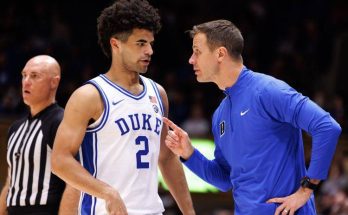Jayson Tatum’s journey to becoming the undeniable face of the Boston Celtics is a story marked by unexpected turns, tough decisions, and a good dose of fate. When the Celtics selected Tatum with the third overall pick in the 2017 NBA Draft, the narrative around him was clear but cautious. Boston had already invested heavily in Gordon Hayward, signing him to a lucrative max contract and positioning him as the team’s offensive cornerstone. Both Hayward and Tatum were wings who needed the ball in their hands to thrive, creating a scenario filled with questions about how the two could coexist — or whether they could at all.
In many ways, Tatum’s rookie season was poised to be a year of apprenticeship and waiting in the wings. Hayward was the established star, the proven scorer, the player who commanded defensive attention and ran the offense. Tatum, meanwhile, was a promising but unproven rookie with a smooth offensive game and a high ceiling. The Boston Celtics, a storied franchise with championship aspirations, were putting their chips on Hayward to lead the way. For Tatum, this meant limited minutes, fewer opportunities, and the challenge of finding his role on a team that already had a designated primary scorer.
But then, fate intervened in a way no one could have predicted. On opening night of the 2017-2018 season, Hayward suffered a horrific injury just five minutes into the game. The gruesome nature of the injury sent shockwaves through the league and left the Celtics without their presumed franchise leader for the foreseeable future. Suddenly, the team’s plans were upended, and the Celtics were thrust into a situation where they needed someone to step up immediately.
That someone was Jayson Tatum.
Thrown into the fire without much warning, Tatum had no choice but to rise to the occasion. He responded with maturity, poise, and a level of performance that belied his rookie status. Over the course of the season, Tatum transformed from a promising prospect to a foundational piece of the Celtics’ future. His ability to score in multiple ways, defend at a high level, and carry the team through critical stretches helped Boston reach the Eastern Conference Finals—a remarkable achievement for a rookie thrust into such a significant role.
Years later, Gordon Hayward reflected candidly on what might have been. “If I stayed healthy, I would’ve been the focus, not Tatum,” he admitted. “I was at the brim of my career. Coach probably would’ve drawn plays for me, not JT.” This honest admission underscores just how precarious and unpredictable the situation was. Hayward’s injury created a vacuum, a moment that redefined the Celtics’ trajectory and opened the door for Tatum’s star to shine.
For Tatum himself, the early days in Boston were far from certain. He wasn’t just trying to prove himself on the court; he was trying to figure out whether this was the right fit for his career. There were whispers and reports that he had considered leaving Boston, not due to conflict or dissatisfaction, but because of the uncertainty about his role and the crowded wing rotation that made it difficult to establish himself. For a young player with immense potential, that kind of uncertainty can be unsettling.
But ultimately, Tatum stayed. And that decision to stay became one of the defining moments not just in his career, but in the Celtics’ franchise history.
What unfolded after that fateful injury was nothing short of remarkable. Tatum’s growth was steady and consistent. Each year, he added new layers to his game—becoming a better playmaker, a more versatile defender, and a more reliable scorer in clutch moments. His confidence soared, and so did his impact on the team. As Hayward returned from injury and other pieces shuffled around the roster, it became clear that Tatum was no longer a rookie with potential; he was a superstar in his own right.
Today, Jayson Tatum is a six-time NBA All-Star, an NBA champion, and the undisputed face of the Boston Celtics. His name is synonymous with the team’s identity, embodying the passion, skill, and relentless pursuit of greatness that Boston fans cherish. What once seemed like a crowded and complicated wing rotation is now a story of opportunity seized and destiny fulfilled.
The story of Tatum and Hayward is more than just a tale of injury and opportunity; it’s a testament to how unpredictable professional sports can be and how resilience, timing, and adaptability shape legacies. Hayward’s injury was a setback for the team, a blow that could have derailed Boston’s season and future plans. Instead, it became the catalyst for one of the franchise’s greatest stories in recent memory.
For the Celtics, the moment Hayward went down was a pivot point. It forced the organization to trust a young player who had only just arrived, and that trust paid dividends. Tatum’s rise was not guaranteed; it was earned through hard work, patience, and a willingness to embrace the moment. His journey from uncertain rookie to franchise cornerstone is a reminder that sometimes the path to greatness is paved with unexpected challenges.
And for Tatum, the choice to stay in Boston and grow within the organization was crucial. Many young players in the NBA face similar crossroads early in their careers—deciding whether to stick with a team where their role is unclear or seek a fresh start elsewhere. Tatum’s decision to remain patient, develop his game, and embrace his role ultimately allowed him to become one of the league’s elite talents.
In the end, Jayson Tatum’s story is one of transformation—of a rookie drafted into uncertainty who, through perseverance and opportunity, became a superstar and champion. It is a story that underscores the importance of timing, the value of resilience, and the power of fate in shaping the course of sports history. The Boston Celtics, a franchise with a rich legacy of greatness, found their next chapter through Tatum’s rise. And for fans, what once looked like a crowded wing position became the defining moment of a new era.
He stayed. He grew. He conquered.


